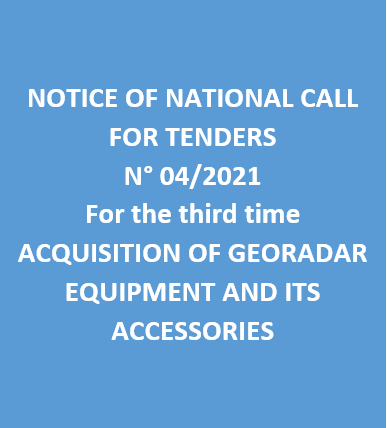| Annual program and technical progress report |
-

Activity Report 2023
-

Technical Program 2024
|
| Geocatalogue |

|
| Invitation to
tender |
-

REALIZATION OF THE TRAINING PLAN FOR THE YEAR 2022
-

ACQUISITION OF TWO SERVICE CARS
-

ACQUISITION OF GEORADAR EQUIPMENT AND ITS ACCESSORIES
|
|
Invest in Tunisia |

|
|
|
|
|
::
Documentation and Editions
>>
Research library
|
| |
|
[
Search by author
]
[
Search keyword
]
[
Search by index
]
[
Search by category
]
|
title of the reference :
|
Palaeo-and recent stress fields in Tunisia and Libya from the cenezoic structural bearing.
|
|
Publication Date:
|
1980
|
|
Author :
|
Schaefer K.
|
|
Catalogue type :
|
Livre
|
|
Catalogue reference :
|
Vol. 9 (DEU) Rock Mech. Vol. 9 Palaeo-and recent stress fields in Tunisia and Libya from the cenezoic structural bearing. Small-scale structural features have been applied as evidence for the existence of horizontal palaeo-stresses within Mesozoic and Cenozoic carbonates of Tunisia and northern and central Libya. Major tectonic elements such as the late Mesozoic evolution of the Sirte graben and horst structures, the Tunisian Atlas folds and grabens, and the Cenozoic Tibesti-Garian volcanic chain have also been considered in this analysis. It is shown that Tunisia and northwestern Libya were subjected to horizontal crustal shortening in the NE-SW direction from the end of the Cretaceous to the Upper Oligocene with a climax during the Middle to Upper Eocene. A different tectonic regime with mainly extensional movements to the NE and volcanic activity was contemporaneously effective from the Tibesti-Garian volcanic chain to the east. Northwestern Libya is presently influenced by a NW-SE directed horizontal principal stress field that already existed during the Middle Miocene. This stress field had a climax during the Upper Pliocene inducing graben formation and folding in Tunisia, and also causing no major rifting in the Sirte basin. It is concluded that the African plate while drifting NE from the Upper Cretaceous through the end of the Palaeogene and moving NW relative to stable Europe during the last 10 m.y. has induced the two tectonic regimes in Tunisia and in northern Libya. The different crustal stress history in the Sirte basin may be due to a continuous NE motion of the African plate after the indentation of Europe during the Upper Cretaceous by the Adriatic promontory as the continuation of Africa from NW-Libya and Tunisia to the north.
bibliogr. contrainte ; Secondaire ; Tertiaire ; Quaternaire continental ; horizontale ; Tunisie : Libye Schaefer K. Tectonique
|
|
Indexation decimale :
|
Tectonique
|
|
Keywords :
|
contrainte ; Secondaire ; Tertiaire ; Quaternaire continental ; horizontale ; Tunisie : Libye
|
|
Summary :
|
Small-scale structural features have been applied as evidence for the existence of horizontal palaeo-stresses within Mesozoic and Cenozoic carbonates of Tunisia and northern and central Libya. Major tectonic elements such as the late Mesozoic evolution of the Sirte graben and horst structures, the Tunisian Atlas folds and grabens, and the Cenozoic Tibesti-Garian volcanic chain have also been considered in this analysis. It is shown that Tunisia and northwestern Libya were subjected to horizontal crustal shortening in the NE-SW direction from the end of the Cretaceous to the Upper Oligocene with a climax during the Middle to Upper Eocene. A different tectonic regime with mainly extensional movements to the NE and volcanic activity was contemporaneously effective from the Tibesti-Garian volcanic chain to the east. Northwestern Libya is presently influenced by a NW-SE directed horizontal principal stress field that already existed during the Middle Miocene. This stress field had a climax during the Upper Pliocene inducing graben formation and folding in Tunisia, and also causing no major rifting in the Sirte basin. It is concluded that the African plate while drifting NE from the Upper Cretaceous through the end of the Palaeogene and moving NW relative to stable Europe during the last 10 m.y. has induced the two tectonic regimes in Tunisia and in northern Libya. The different crustal stress history in the Sirte basin may be due to a continuous NE motion of the African plate after the indentation of Europe during the Upper Cretaceous by the Adriatic promontory as the continuation of Africa from NW-Libya and Tunisia to the north.
|
|
Exemplaries :
|
TU739
|
|
|
|
|
|
|
|



